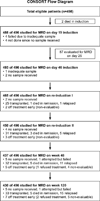Clinical utility of sequential minimal residual disease measurements in the context of risk-based therapy in childhood acute lymphoblastic leukaemia: a prospective study
- PMID: 25800893
- PMCID: PMC4612585
- DOI: 10.1016/S1470-2045(15)70082-3
Clinical utility of sequential minimal residual disease measurements in the context of risk-based therapy in childhood acute lymphoblastic leukaemia: a prospective study
Abstract
Background: The level of minimal residual disease during remission induction is the most important prognostic indicator in patients with acute lymphoblastic leukaemia (ALL). We aimed to establish the clinical significance of minimal residual disease in a prospective trial that used sequential minimal residual disease measurements to guide treatment decisions.
Methods: Between June 7, 2000, and Oct 24, 2007, 498 assessable patients with newly diagnosed ALL were enrolled in a clinical trial at St Jude Children's Research Hospital. We provisionally classified the risk of relapse as low, standard, or high according to patients' baseline clinical and laboratory features. Final risk assignment to establish treatment intensity was based mainly on minimal residual disease levels measured on days 19 and 46 of remission induction, and on week 7 of maintenance treatment. Additional measurements of minimal residual disease were made on weeks 17, 48, and 120 (end of treatment). The primary aim was to establish the association between event-free survival and patients' minimal residual disease levels during remission induction and sequentially post-remission. This trial was registered at ClinicalTrials.gov, number NCT00137111.
Findings: Irrespective of the provisional risk classification, 10-year event-free survival was significantly worse for patients with 1% or greater minimal residual disease levels on day 19 compared with patients with lower minimal residual disease levels (69·2%, 95% CI 49·6-82·4, n=36 vs 95·5%, 91·7-97·5, n=244; p<0·001 for the provisional low-risk group and 65·1%, 50·7-76·2, n=56 vs 82·9%, 75·6-88·2, n=142; p=0·01 for the provisional standard-risk group). 12 patients with provisional low-risk ALL and 1% or higher minimal residual disease levels on day 19 but negative minimal residual disease (<0·01%) on day 46 were treated for standard-risk ALL and had a 10-year event-free survival of 88·9% (43·3-98·4). For the 280 provisional low-risk patients, a minimal residual disease level of less than 1% on day 19 predicted a better outcome, irrespective of the minimal residual disease level on day 46. Of provisional standard-risk patients with minimal residual disease of less than 1% on day 19, the 15 with persistent minimal residual disease on day 46 seemed to have an inferior 10-year event-free survival compared with the 126 with negative minimal residual disease (72·7%, 42·5-88·8 vs 84·0%, 76·3-89·4; p=0·06) after receiving the same post-remission treatment for standard-risk ALL. Of patients attaining negative minimal residual disease status after remission induction, minimal residual disease re-emerged in four of 382 studied on week 7, one of 448 at week 17, and one of 437 at week 48; all but one of these six patients died despite additional treatment. By contrast, relapse occurred in only two of the 11 patients who had decreasing minimal residual disease levels between the end of induction and week 7 of maintenance therapy and were treated with chemotherapy alone.
Interpretation: Minimal residual disease levels during remission induction treatment have important prognostic and therapeutic implications even in the context of minimal residual disease-guided treatment. Sequential minimal residual disease monitoring after remission induction is warranted for patients with detectable minimal residual disease.
Funding: National Institutes of Health and American Lebanese Syrian Associated Charities.
Copyright © 2015 Elsevier Ltd. All rights reserved.
Figures





Comment in
-
Minimal residual disease monitoring: a new era for childhood ALL.Lancet Oncol. 2015 Apr;16(4):362-4. doi: 10.1016/S1470-2045(15)70123-3. Epub 2015 Mar 20. Lancet Oncol. 2015. PMID: 25800894 No abstract available.
References
-
- Campana D. Minimal residual disease monitoring in childhood acute lymphoblastic leukemia. Curr Opin Hematol. 2012;19:313–318. - PubMed
-
- Schrappe M, Valsecchi MG, Bartram CR, et al. Late MRD response determines relapse risk overall and in subsets of childhood T-cell ALL: results of the AIEOP-BFM-ALL 2000 study. Blood. 2011;118:2077–2084. - PubMed
-
- Conter V, Bartram CR, Valsecchi MG, et al. Molecular response to treatment redefines all prognostic factors in children and adolescents with B-cell precursor acute lymphoblastic leukemia: results in 3184 patients of the AIEOP-BFM ALL 2000 study. Blood. 2010;115:3206–3214. - PubMed
Publication types
MeSH terms
Substances
Associated data
Grants and funding
LinkOut - more resources
Full Text Sources
Other Literature Sources
Medical

